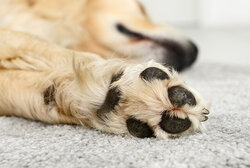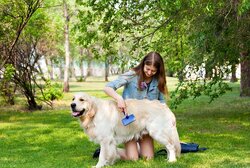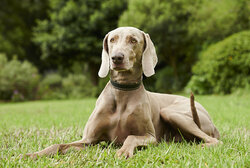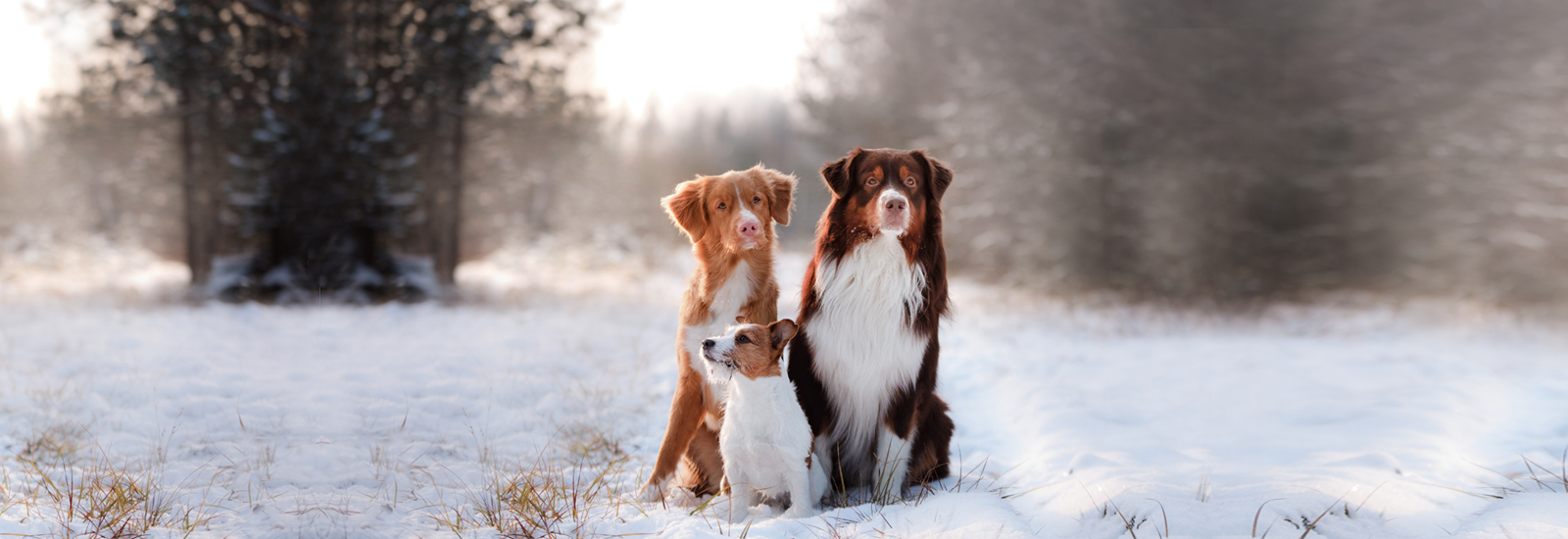Paw care for dogs
In winter, the paws of our dogs are exposed to particular risks: ice, snow, de-icing salt and grit can lead to fine cracks and fissures. Find out here everything you need to know about proper paw care for dogs and how you can make your own paw balm!
Dogs love snow
Many dogs adore snow. For puppies, the snowy landscape is a new world to explore, and adult dogs already know how much fun they can have in it. Even older dogs often cannot resist the joy of running through the snow again. We can only guess what exactly the fascination for dogs is. Perhaps the snow covers up the numerous smells and makes the search all the more interesting. One typical winter scene is a dog sticking its head in the snow. And then it suddenly dashes off again like a whirlwind.
However, the cold, ice and snow can leave their mark on a dog’s paws and put them under a great deal of physical stress. This is why you should take plenty of time to care for your dog’s paws, especially in winter.
Paw care for dogs - What are the dangers
Dogs have the most frequent direct contact with their environment through their paws. This primarily affects their pads, but also their claws and the hair between the pads. It is important to regularly pay attention to all of these, because if they are not cared for, problems may arise at some point:
- If the claws are too long, the resulting pressure pain can lead to misalignment of both the claws and the legs.
- If the hairs between the pads become too long, they can become matted and increase the risk of skidding on slippery ground. Outdoors in the snow, they can also cause clumps of snow to form more quickly between the toes.
- If the pads become dry and brittle, small, painful cracks can occur, especially in combination with ice, de-icing salt and grit. The same applies if the dog walks on hot asphalt in summer or steps on a piece of broken glass or a thorn.
We recommend that you have the following basic items for regular paw care:
- a pair of claw scissors
- a dog nail file
- a pair of scissors to trim the hair between the pads
How can you recognise problems with your dog's paws?
There are several tell-tale signs that your dog has a problem with its paws. If for example you hear a clicking sound when the dog walks over a smooth floor, it might be time to cut its claws. This also reduces the risk of slipping. This can also be caused by the hair between the pads growing too long. Simply cut them flush. This also reduces the risk of small clumps of snow forming between the pads.
If any small clumps of snow have formed, the dog will lift up its paw and chew or lick it intensively. You can easily tell that these are forming when the dog lifts up or chews on a paw. Our four-legged friends display similar behaviour when they come into contact with de-icing salt. Even the tiniest cracks can cause the salt to penetrate the pads which then start to burn. Even the tiniest cracks can cause salt to penetrate the pads and lead to a burning sensation
8 tips for paw care for dogs
- Paw care for dogs is not only about the pads, but also about the claws. How often do I have to trim my dog’s claws? They should be shortened as soon as the dog starts to stand or walk on them. Be careful not to cut them down too far, as this can lead to bleeding. It is also possible to have your pet’s claws trimmed by a vet.
- The hair growth on the paws of our dogs can vary considerably. If the hair is too long, it should be cut. In winter, this reduces the risk of clumps of snow forming between the toes.
- A dog’s pads are about 50 times thicker than the rest of its skin. Despite this, they can still be damaged by cold or heat, as well as by mechanical impact such as stones, thorns or liquid substances. The paws should therefore be examined regularly.
- Any obvious cut in the pads should always be examined by a vet, as only they can assess whether there is any damage to deeper tissue.
- You can treat brittle pads yourself. Vaseline and milking fat are not suitable for this because they are made using mineral oil. Paw balm for dogs is much more suitable.
- In snowy and icy conditions, it is advisable to put balm on your dog’s paws before going for a walk. Make sure that you only use special paw balm for dogs.
- The type of paw care that should be provided after a walk depends on the particular circumstances. If the walk has been through the town and the dog is likely to have come into contact with de-icing salt, the paws should be washed with lukewarm water. It is then advisable to dry the paws thoroughly to prevent a moist environment forming in which pathogens can spread more easily.
- As soon as the paws are dry, you can always apply another thin layer of paw cream. This has the same effect as applying cream to your hands after washing up. The skin is thus provided with moisture and stays soft.
Make your own paw balm - for keeping your dog's paws soft and healthy
Would you like to make your own paw balm for your four-legged friend? You just need a few ingredients for our DIY paw balm, which is quick and easy to make!
Ingredients for a small jar of paw balm:
- 10 g beeswax
- 2 tbsp dried chamomile flowers
- 70 g organic coconut oil
- 1 tbsp almond oil
- small jar with screw cap
Step 1: Weigh out around 70 g of coconut oil and melt in a saucepan over a low heat.
Step 2: Add 2 tablespoons of chamomile flowers to the melted coconut oil and gently simmer in the saucepan for 20-30 minutes, stirring occasionally.
Step 3: Strain the chamomile flowers with a sieve and return the oil to the saucepan.
Step 4: Add 10 g of beeswax to the oil in the saucepan and allow it to melt, stirring briefly.
Step 5: Add 1 tablespoon of almond oil and stir again.
Step 6: Pour the mixture into a jar, leave to cool and then screw shut.
The paw balm should be kept in a cool, dark place. Make sure that once opened, the paw balm does not become contaminated during application.
You can apply the DIY paw balm to your dog’s paws before and after going for a walk. This will keep them soft and protected! Warm the paw balm a little in the palms of your hands and then massage it into the clean paws. We wish all dog owners and their dogs lots of fun with this natural paw care!
The advantages of using a dog paw balm
The paws of our dogs are vulnerable to different degrees. If you know that your four-legged friend often has problems with its paws, you should be very conscientious when it comes to caring for your dog’s paws. This means that in winter it is best to apply paw balm to your dog’s paws daily or even before every walk. This provides the pads with excellent protection against cold and road salt. For dog sled drivers, this is standard procedure before every journey.
Tip: When caring for your dog, don’t just think about its coat, but also regularly examine its paws. They are at work in all weathers and with vulnerable dogs they require special care.
You may also like this

Dogs in winter
Ideal items, care and nutrition

Cutting a dog’s claws
How to cut your dog’s claws

Moulting in dogs
How to help your dog during moulting

If your dog is limping
Any lameness should be examined by a vet as soon as possible
